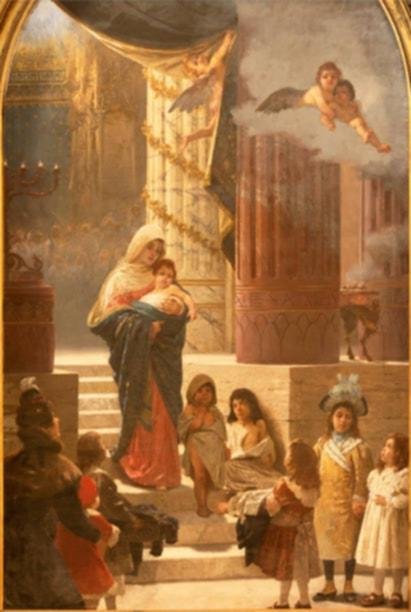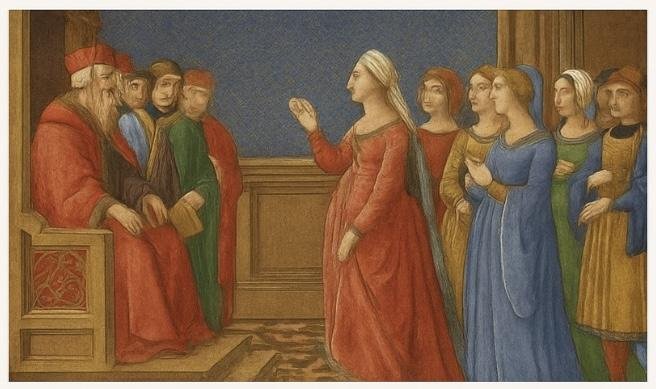Endurance and Identity: The Fortunes of Madam Beritola

Introduction
Giovanni Boccaccio’s The Decameron often explores the unpredictability of fortune and the resilience of the human spirit. In Day 2, Tale 6, the story of Madam Beritola follows a noblewoman whose life is overturned by political upheaval and separation from her family. Through a series of trials, she endures loss, disguise, and eventual reunion. This tale’s core theme centers around endurance in the face of adversity, and how personal identity survives even when outward circumstances shift dramatically. It offers a moving reflection of 14th-century values of honor, loyalty, and social restoration, while still speaking to modern readers who grapple with identity and resilience amid life’s uncertainties.
Summary
Madam Beritola, the wife of a nobleman from Naples, is forced to flee after her husband is arrested for political reasons. She ends up on a deserted island with her two sons. One son disappears and is later found and raised by a Genoese family, while the other remains with her. Beritola, in disguise, enters into the service of a noblewoman. Meanwhile, her lost son rises through fortune and falls in love with his master’s daughter. Eventually, the identities of Beritola and her sons are revealed, leading to their joyful reunion and the restoration of their social status.
Analysis
Theme and Moral:
The central theme of the tale is the endurance of noble identity and virtue through misfortune. Despite immense suffering and social displacement, Madam Beritola and her family maintain their dignity. The tale suggests that fortune is unpredictable, but noble character will eventually be rewarded. The moral lies in the idea that patience and virtue, even in exile and disguise, can withstand the storms of fate.
Characters and Motivation:
Madam Beritola is the tale’s emotional core—her stoicism and maternal devotion drive the narrative. Her actions are dictated by love for her children and loyalty to her absent husband. Her sons, particularly Giannotto (later known as Currado), represent the theme of hidden nobility. Their motivations align with survival, love, and ultimately, reclaiming their rightful identity. Secondary characters, like Currado (the master) and his daughter, facilitate the family's return to fortune and reinforce the social values of generosity and familial respect.
Literary Devices:
Boccaccio uses irony and symbolism subtly. The goat (which Beritola befriends while on the island) becomes a symbol of humble endurance and adaptation to harsh conditions. There’s also dramatic irony, as the audience knows the identities of the characters long before they do. Fortune is a recurring motif in The Decameron, personified almost as a character itself, highlighting the instability of human life. While not a comedic tale, it does contain an undercurrent of narrative justice—those who are patient and morally upright are ultimately rewarded.
Cultural Context and Modern Resonance:
In 14th-century Italy, issues like political exile, class identity, and arranged marriage were very real concerns. The story reflects anxiety over losing one’s social standing and the hope for restoration. It also affirms the importance of lineage and virtue. Today, the tale still resonates in how it portrays displacement, resilience and reunion—common themes for people facing migration, identity struggles, or family separation. Madam Beritola’s quiet strength speaks especially to modern readers dealing with personal upheaval and seeking hope.
Personal Response
What stood out most to me was Madam Beritola’s quiet resilience. She never becomes bitter, even when stripped of everything. Her patience and quiet suffering made me reflect on how often we overlook the strength it takes to endure rather than act. While the tale was less dramatic than others in The Decameron, its emotional payoff—especially the reunion scene—was deeply satisfying. I appreciated how Boccaccio wove a story that was both melancholic and uplifting.
Conclusion
The tale of Madam Beritola reminds us that nobility isn't just a title but a way of living with dignity and compassion, even in the harshest circumstances. Boccaccio’s message about the endurance of identity and virtue continues to resonate in an age where many people face displacement or hardship. Her story is a powerful example of how storytelling can preserve human values across centuries.








